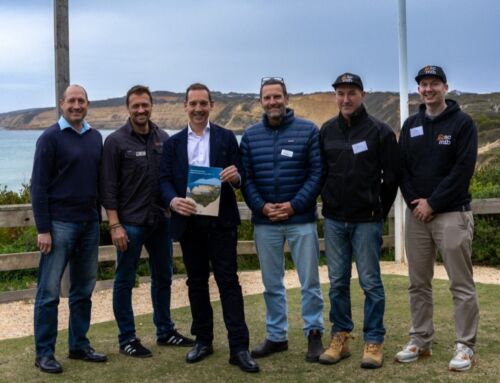Rail trails are a powerful tool in (re)connecting community and energising local economies, writes TRC Associate, Chris Ord.
“The loss of a railway was much more than a transport inconvenience to countless communities, more than the destruction of something that brought people together,” wrote Anthony Lambert in Lost Railway Journeys: Passenger Journeys that Time Has Erased.
He was, of course, musing on the loss of the engines and carriages that rolled seamlessly along iron rails, connecting countless towns and cities across the world, including across Australia’s vast landscapes. He was also musing on the cascade of losses that the disappearance of railways seeded – loss of connection, of economies, but also of an important social and recreational experience.
Practical connection and recreation had coalesced on rail and in doing so, the economic boom that railways delivered evolved from something based purely in the economics of delivering goods, to one that doubled down by delivering visitors spending money in places it may otherwise never have reached.
As the sixties rolled around, a boom in motor vehicle sales and an ever-expanding network of roads meant that the demise of many train lines was inevitable. The deletion of train timetables heralded the disappearance of an inbound economy for many places, and with it the disconnection of towns and communities that once were linked by that iron corridor.
But what if the disappearance of trains and iron rails didn’t necessarily precipitate such losses? What if an alternative use for dismantled and often scenic railway routes was employed? What if leg-power rather than steam, diesel or electric was the fuel that re-invigorated the value of railway routes to communities?
Today, tourism is recognised as crucial to the economy of many rural towns where other forms of industry has long since disappeared. This reliance of regions on the holidaying crowd has been magnified by COVID-19 with travel restrictions stemming the flow of tourists and with it all but cutting off vital income.
Additionally, we now face increasing health issues, in no small measure due to lack of physical activity; mental health issues are at epidemic levels in part due to social dislocation; and there is a recognised disconnect from nature.
While no silver bullet, the role of rail trails in addressing to some degree all of these issues has never been more apparent, and the importance of rail trails to our communities, never been greater.
Rail trails as a concept gained popularity from the moment lines began being decommissioned. Railways bereft of trains began being used informally by walkers to commute between towns and for leisure, the personal benefit a more pleasurable and safer experience compared to that of roadside routes where speeding vehicles made for unpleasant and often dangerous walking or riding. It was only a matter of time that a disused railway was identified as a potential drawcard asset not just for locals getting out and about, but as a tourism attraction leveraged by regions blessed with beautiful landscapes.
There is no definitive marker on the first ever designated rail trail, but the Elroy-Sparta State Trail in Wisconsin, USA, would be among the first officially recognised, opening in 1967. Nearly 24 years later, the Rails to Trails Conservancy organisation reports around 100 million users per year enjoying more than 38,000km of trail on more than 2,130 rail trails with another 812 being planned to add another 14,000km to the network[1].
In addition to USA, Canada and across Europe closely followed the rail trail movement, where rail networks were abundant but suffering from abandonment with the swift move of industry to road. Germany and the UK now hold the mantle for the most rail trails, emphasised by the alchemy of a historically intensive rail network, townships in close proximity and larger populations.
In Australia, railways initially solved the tyranny of distance, and indeed, the longer the railway route, the more economies of scale play well for cargo transport, the less likely the route to be decommissioned. So it makes sense that it was the smaller, more remote and rural lines that shut down first. In doing so they proved ripe for transition to rail trail use. Conversion of corridors to rail trails in Australia is a relatively recent phenomenon, driven by the closure of many railways in the 1980s and 1990s (although closures have beenrolling since the end of World War 2).
That opportunity has been taken advantage of by councils across Australia, with Rail Trails Australia listing 147 official rail trails on its website (http://www.railtrails.org.au/). Victoria takes the mantle as the Rail Trail State, with 44 routes accounting for approx. 1150km of trails[2] with plenty more on the lobby board.
Rail trails often evolve into nationally significant experiences, drawing significant visitation from interstate and international markets. Trails such as Murray to Mountains (Vic), the Riesling Rail Trail (SA) , Brisbane Valley Rail Trail (Qld) or the Otago Central Rail Trail (NZ), have become popular destination targets for cycle tourists worldwide.
Increased participation in cycling and walking, especially in natural environments such as those traversed by rail trails, has thrown further community spotlight on rail trails. So too, has their accessibility, linking as they do into small towns.
The inherent nature of a trail being built on a railway line also means they avoid steep grades by contouring around hills, going through cuttings and over bridges. Railway engineers (and trains) have never liked steep inclines, so routes are in the main genteel, grades usually being 1-in-40, meaning a line would rise only 1 metre in every 40 (roads can have grades as steep as 1-in-6). The lack of steep terrain has made rail trails particularly appealing to the broadest possible cross section of community.

Murray to Mountains Rail Trail. IMAGE SOURCE: ridehighcountry.com.au
Supporting rural economies
But just what is the value of a rail trail to that community? Why spend millions refurbishing an old railway line that is serving quite well as a sheep paddock, thank you very much? Quite directly, it puts money in the pockets of local businesses and helps keep regional towns vibrant.
Feasibility studies clearly show how rail trails contribute to the local economy via attracting visitor expenditure, prompting extra spend by locals, creating jobs via maintenance and build work, and business stimulus by providing public amenity around which operations such as tours, events and retailers can leverage increased business.
In New Zealand, a 2011 survey of the Otago Central Rail Trail estimated the direct economic impact of the trail to be $8.1 million[3]. An earlier study conducted less than five years after opening showed that 64% of accommodation providers operating prior to opening attributed more than 20% of turnover to visitors using the rail trail; 80% of accommodation providers who set up businesses after the trail opened attributed more than 20% of turnover to people using the Trail; and 53% of these businesses attributed more than 60% of their turnover to the rail trail[4].
A rail trail feasibility study carried out by TRC Tourism for a proposed 30km Casterton-Merino Rail trail route in Victoria assessed a total benefit of $11.098 million over a ten-year period with a projected 20,000+ users of which nearly 19,000 would be visitors to the region.
A demand and economic benefit assessment of the proposed rail trail between Launceston and Billycock Hill, near Ledgerwood, Tasmania found that five years post-construction, the Rail Trail will create $6.8million per annum of economic impact in the region with the creation of 40 new jobs. This benefit grows to $11.2 million per annum after 15 years[5].
Economic modelling around the Riesling Trail in South Australia’s Clare Valley estimated a direct economic impact of at about $1 million a year (based on expenditure of $216 per person)[6].
The business case supporting the now-finished Brisbane Valley Rail Trail estimated that at five years post construction it would increase direct tourism expenditure in the region by $1.5 million per annum.
At fifteen years post construction it is estimated to increase economic output in the region by $2.2 million per annum and support 58 jobs[7].
An economic impact study of the Murray to the Mountains Rail Trail, Warburton Rail Trail and East Gippsland Trail – all located in Victoria – found that, on average, for every visitor day at the rail trails, $51.10 of expenditure is injected into the economy (Beeton, 2003[8]). Another study conducted on the Murray to the Mountains Rail Trail[9] found that the average expenditure per person per day visiting the rail trail was $483.00, again reinforcing the appeal rail trails as economic generators.
A study by Tourism North East focusing on the Murray to Mountains revealed that recreational cyclists contributed around $26.2 million in regional output, and $13.6 million in regional value, supporting 22.7 jobs[10].
An important component of the economic benefits delivered by a rail trail is the development of jobs. While in the construction phase (usually 12 months to two years), trail build can support 50+ jobs while the ongoing operations phase of a trail represents significant employment in maintenance, management, tourism and associated increased employment in support sectors such as retail and accommodation.
The Casterton to Merino feasibility study conducted by TRC Tourism (2019) forecast 52.4 FTE jobs in its construction phase and 22.1 FTE jobs in the operations phase ongoing by year ten. The Otago Central Rail Trail in New Zealand reportedly supports 1,000 full and part-time jobs and helped create 200 additional or part-time jobs[11].
Tourism
Rail trails often develop into high-value tourism drawcards, visitors attracted by their ease and freedom of use, appealing landscapes and connection to other high value tourism experiences such as wineries, breweries, farm food gates, township markets, getaway accommodation, cultural and historical attractions.
The Murray to the Mountains Rail Trail established in 2009, attracts 45,000 users per annum. 59% are cyclists, the majority spending 2-3 days on Trail, extending their stay and expenditure. The Otago Central Rail Trail hosts nearly 15,000 users per annum, a figure that doesn’t include the thousands of local and regional users who also make use of the trail. The Hauraki Rail Trail, also in New Zealand, has patronage of more than 21,000 per year.
Equitable Accessibility
Rail trails are a great opportunity to provide comfortable and accessible outdoor active experiences for all. Their ‘ease of engagement’ given their relatively flat, wide and non-technical design means there are few barriers to use. Importantly, they offer not just easy, but equitable access to outdoors: they are extremely popular with all types of cyclists, walkers, hikers, horse riders (where permitted), joggers, and trail runners. They are also ideal for those in wheelchairs, people in mobility scooters (gophers), parents pushing prams, school groups, clubs and families. There is no cost to use a rail trail, meaning they are a relatively discrimination free zone no matter the user’s station in society or physical limitations.
Community amenity
Riding off the back of increased visitation and expenditure generated by rail trails, community amenity often improves with new businesses opening, and established businesses investing in and improving service offerings. This can give local residents more choice in hospitality options while also increasing potential for new business initiatives. A TRC Tourism report on the Otago Central Rail Trail indicated that 29% of survey respondents said that the rail trail was very important in their decision to buy or start their business.
Rail trails also seed local infrastructure investments such as car parks, public toilets and playgrounds, further improving community facilities and amenity.
The implementation of rail trails can also prompt increased community ownership of the corridor space and adjacent environments, which can assist in preserving local natural and cultural values and encourage community participation in conservation and revegetation work.

Brisbane Valley Rail Trail. IMAGE SOURCE: Brisbane Valley Rail Trail Users Association Inc
Safety
The off-road nature of rail trails – routed away from busy vehicle traffic thoroughfares, provides a safe environment for cyclist and pedestrians (and horse riders) to walk, run or ride. By taking away any potential vehicle interaction with users, the risk of accident is significantly reduced, with road crossings the only potential zone of conflict. Put bluntly, getting cyclists off road and on rail trails saves lives. This is in a context where the number of cyclist deaths in Australia has doubled over the last three years. In the 12 months to June 2020, 48 cyclists died on Australian roads, compared to 34 deaths in the previous corresponding period – a year-on-year increase of more than 40%[12].
While real safety factors are undoubtedly increased, it is also the perceived safety benefits that matter, with a safer riding environment encouraging more people to be more active outdoors. The Victorian Cycling Strategy (2018-28) reports that about 60% of Victorians are curious about cycling but are deterred by real or perceived safety concerns of riding on a road. Separating cyclists and motor vehicles as a rail trail makes cycling more comfortable by reducing traffic stress and encourages increased participation by those curious about cycling but worried about safety.
Active Transport
As is their original intent, rail trails physically connect townships and communities. With a rise in the number of people moving to rural areas for work and lifestyle benefit, the role of safe, off-road pathways that allow access to and between townships where locals work, shop and socialise has never been more important. Indeed active transport is a focus for most local government authorities and central tenet for state and federal government agencies with remits in transport and community health.
There has been a recognised movement toward more sustainable travel and commuting, with more people electing to walk or ride a bike to their place of work or retail and social spaces. Rail trails that connect to townships that are regional employment nodes become crucial commuting infrastructure, allowing people to move between satellite villages and larger workplace centres. This enhances the attractiveness of regional towns as places for business to be based, and for employees to want to live. Rail trails become critical cogs in making rural communities viable in terms of employment and attractive in terms of lifestyle and liveability indices.
Health and wellbeing
Boosting the number of people, walking, running, cycling and generally being active outdoors is an important factor in making neighbourhoods more vibrant places to live. The result is healthier people and healthier communities. Councils and land managers increasingly and indeed unanimously recognise the contribution of open spaces and parklands to the connection of community. Parks Victoria’s strategy describes several directions relevant to rail trails including that the wellbeing of societies depends on healthy ecosystems; that parks nurture healthy ecosystems; that contact with nature is essential for improving emotional, physical and spiritual health and well-being; and that parks are fundamental to economic growth and to vibrant and healthy communities. Rail trails, while built environments, can be contextualised as ‘corridors of parkland’.
Rail trails stimulate increased activity, particularly within local communities in proximity to the trail who appreciate the safety and amenity of an off-road space in which to undertake physical activity, be that walking, running, cycling or horse riding. The Victorian Trails Strategy 2013-2023 recognises that “Sections in close proximity to towns and cities often form part of regular fitness circuits used by local residents.”
A report by Marsden Jacobs Associates (2016) indicates that the exercise generated in cycling and active walking has net healthcare benefits in lifetime health costs. The health benefit resulting from the Casterton-Merino Rail Trail was estimated at $3.765M over 10 years.
Data from the USA indicates that every $1 of funds spent on recreational trails yield direct medical benefits of $2.94[13]. Trails encourage people to exercise – the economic benefit to society of getting an inactive person to walk or cycle is between $5,000 and $7,000/year. Trails can also provide a target facility for so-called “green scripts”. Several State governments in Australia have investigated working with the medical profession to determine the outcomes of a doctor “prescribing” a patient to spend time outdoors. The practise already happens in New Zealand. Green scripts are seen as part of an approach to treat and prevent heart disease, high blood pressure, obesity and mental health issues. Rail trails offer one of the safest and most inviting environments for people to fulfil their doctor’s prescribed ‘outdoor medicine’.
Environment
Generally speaking, the design of the trails focus on protecting the natural environment, heritage and rural character. Trails provide great opportunity to combine sustainable trail development with restoration and all-important ongoing maintenance of the biodiversity of rural and regional areas. They provide a long, continuous natural heritage corridor where native vegetation rehabilitation and weed control become a major focus for the committees of management and councils who maintain rail trails. In some instances, disused railway land parcels become prime cultivating ground for invasive species, and with little oversight it can become rampant, threatening native species. The establishment of rail trails focuses the attention of land managers, and maintenance staff and volunteers on previously neglected land, the result usually a restoration back to a more natural state. This in turn benefits local wildlife.
Rail trails exist on previously disturbed areas. Instead of carefully designing a new trail that is considerate of environmental and cultural impacts, land tenure, drainage and erosion issues – a disused railway mitigates the needs to construct and disturb new areas, with drainage, erosion and land tenure considerations in many instances already taken care of.
More broadly, environmental benefits of walking and cycling are achieved through reduced motor vehicle use leading to reduced congestion and vehicle emissions, improved local air quality and reduced carbon dioxide (a significant greenhouse gas associated with global warming) in the atmosphere. Analysis suggests that a 20% shift in trips from motorised modes to bicycles would result in reduced air pollution and emissions for an annual environmental benefit of $33 million[14].
Education
Rail trails also present unique opportunities for public education. With appropriate on and off trail interpretation and user information, they can highlight unique environmental, cultural and historical points of interest linked to the trail and the landscapes it travels through. In essence rail trails can be leveraged as outdoor classrooms, engaging users in the stories of place and history tied to them. This in turn grows a sense of connection between the user and the trail environment, fostering a sense of value and stewardship for it and the landscapes in which it is hosted.

Otago Central Rail Trail. IMAGE SOURCE: otagocentralrailtrail.co.nz
For more advice on establishing feasibility, strategy, infrastructure and experience design for your proposed rail trail project, contact TRC Tourism.
Further reading: www.railtrails.org.au
[1] http://www.railstotrails.org/our-work/research-and-information/national-and-state-trailstats/
[3] Central Otago District Council, 2011
[4] Otago Central Rail Trail Trust, 2005
[5] https://ntdc.org.au/wp-content/uploads/2018/10/NE-Rail-Trail-TRC-assessment-Final.pdf
[6] Faulks P et al (2008) Cycle tourism and South Australia destination marketing.
[7] https://www.somerset.qld.gov.au/downloads/file/2070/business-case-pdf
[8] An Economic Analysis of Rail Trails in Victoria, Latrobe University, Dr Sue Beeton (2003)
[9] Cycling in Regional Communities: A Longitudinal Study of the Murray to Mountains Rail Trail. La Trobe University, Australia. Dr Sue Beeton (2010)
[10] SGS Economics and Planning (2012), North East Victoria Tourism Gap Analysis
[11] “Cycleway the only way”, Hueber, Andre (19 June 2011). The New Zealand Herald
[12] https://www.caradvice.com.au/870483/cyclist-deaths-australia/
[13] A Cost-Benefit Analysis of Physical Activity Using Bike/Pedestrian Trails. Health Promotion Practice, Wang, G. et al. (2005).
[14] Cycling Into the Future 2013-23, Victoria’s Cycling Strategy
COVER IMAGE – SOURCE: otagocentralrailtrail.co.nz







